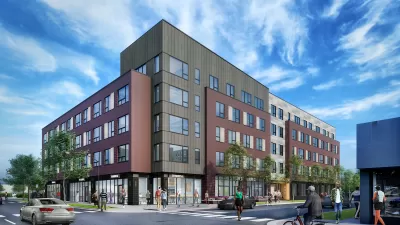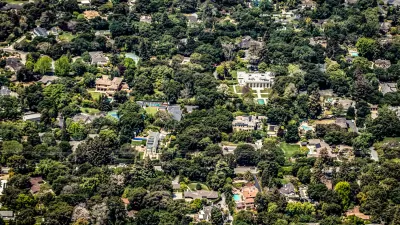Houston or Holland? The rapidly growing suburbs of Madrid uncomfortably (and instructively) amalgamate some of both. I was lucky to receive a recent tour from David Cohn, a long-time colleague and 20-year resident of Madrid; Sylvia Perea, a post-doctoral student and, until recently, an editor at the journal Arquitectura Viva, and Emilio Ontiveros, a young architect of the local Research Group on Social Housing.
Houston or Holland? The rapidly growing suburbs of Madrid uncomfortably (and instructively) amalgamate some of both. I was lucky to receive a recent tour from David Cohn, a long-time colleague and 20-year resident of Madrid; Sylvia Perea, a post-doctoral student and, until recently, an editor at the journal Arquitectura Viva, and Emilio Ontiveros, a young architect of the local Research Group on Social Housing.

Construction is one of Spain's biggest industries, which is unsurprising to anyone who has spent even a few days dodging scaffolding and detouring around excavations. And both public and private building is booming. The M-40, for example, a freeway extravaganza that any sunbelt city would find familiar, is part of an extensive new network of beltways and outer beltways that are responsible for a doubling of Madrid's urbanized area since the 1970s.
But the investment in other forms of transportation is equally impressive. Lines added to the extensive Metro rail network have accompanied the outer-suburban growth: the regeneration of the traditionally poorer southern side of Madrid has been boosted by the massive Metrosur, a rail ring that was built in just four years. Visitors to Madrid arrive in what is arguably the world's most beautiful airport complex, Terminal 4 at Barajas. It certainly helped its architect, Richard Rogers (with local architect Lamella Studio), win this year's Pritzker Prize. 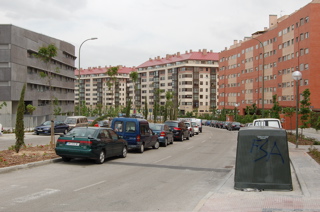
Seven- to nine-story blocks stamped out of much the same mold found all over Spain line a street in Sanchinarro, a new northern suburb. There's an apparent dense urbanity, but that's deceptive. Each block wraps a courtyard (easy to watch the kids), but they're hermetic, gated from each other.

Few people walk anywhere. The government possesses considerable land-use and planning powers but tends to bulldoze land with abandon in pumping out these new towns, each much like the next. This is pretty much the result.
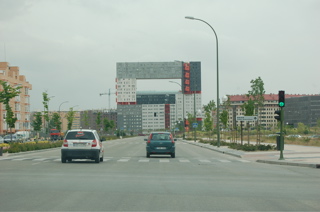
The real Sanchinarro comprises huge megagrids of grandiose avenues. (more about the striking tower later.) They are united by enormous roundabouts, like the one below.
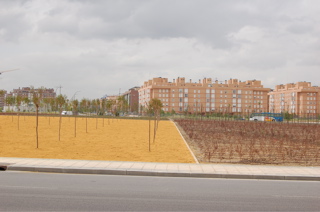
The municipal planners set aside equally large spaces for parks, which have a similarly civil-engineered feel (below). (I'm told there's little tradition of landscape architecture in Spain.)

Below: Lots of leftover space seems not to have been thought about at all. In spite of the high-density housing construction, the overall density of these new towns is probably little different from the spec suburbs of the American West.
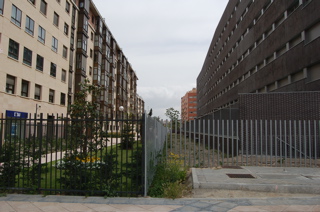
Though its focus on the automobile will seem familiar to Americans, the inclusion of considerable social housing (what American's would call public housing or "affordable" housing) isn't. Like many Americans, Madrilenos move ever-farther from the costly center to find affordability. But there is a diversity of incomes in the new towns, in contrast to Americas rigidly income-separated communities.
The design of social housing is selected by competition and focuses on young architects who want to build their careers by making an impression. So the most distinctive and innovative buildings are built for those of lowest incomes.
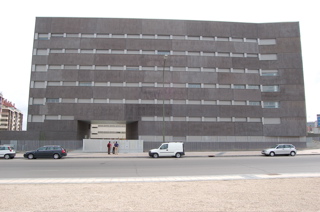
Combine tight budgets and young talent, though, and you have structures that make clever visual statements but do not advance the art of humanely housing people, like this 170-unit project in tinted concrete by Burgos and Garrido
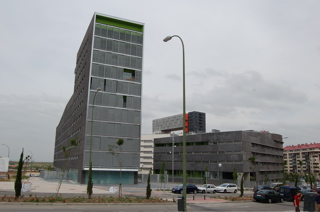
The courtyard opens appealingly to capture southern winter light, but the ubiquitous fencing (and a budget that inevitably runs out before the courtyard can be landscaped) gives the feeling of a permanent construction site
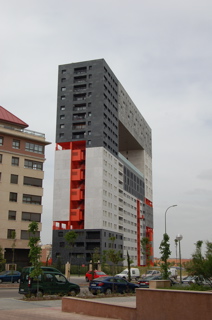
The well-known Dutch architect MVRDV built a landmark for Sanchinarro by turning the standard courtyard scheme into a tower with a "mirador," a public plaza placed high in a hole cut through the building. With a mix of materials and colors, the building evokes a vertical city, but we were greeted in a somewhat hostile manner by tenants, who were either unhappy with the building or with the number of architectural tourists it had attracted – it was a little hard to tell.
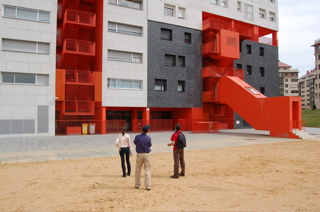
Tellingly, they clustered at the tiny stoop emitted by a fire stair to watch their children play (I didn't take a picture of the people). The Spanish instinctive sociability asserting itself. There were park benches they might have used in the garden that was supposed to be planted around the tower, but only untended weeds grew there. The real entrance to the building is a gated and fenced red-painted slot to the left of the sculptured stair in the image above.

We checked out some more social housing to the south of Madrid, in Carabanchel. This one (I've misplaced the architect's name) creates sculptural interest with cantilevered rooms, – there's a level of architectural adventure in these projects still unknown in the U.S.
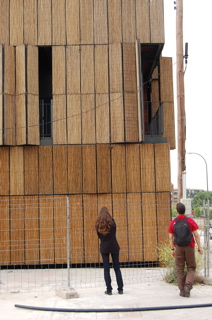
London-based Foreign Office Architecture created this prism (still in construction) lined with external galleries. Bi-fold bamboo-clad panels protect them from the sun. I got the feeling that the galleries would feel like a shady porch in the tropics rather than a suburban balcony outside dusty Madrid. Clever means of shading and filtering the hot sun abound in the work we saw – simple stratagems America could readily adopt in this climate-change era. These housing projects also tend to include clothes-drying porches to avoid the use of dryers and to tastefully conceal clotheslines.
In older cities, Spanish architects often compose austerely brilliant plazas and streetscapes, but the lessons old cities can teach seems all but forgotten in the new communities. I was disappointed by the treatment of doorways as incisions rather than thresholds with both architectural and social potential, for example. How people share space, and rich possibilities in the transitions between public and private are surprisingly ill-considered, with the result that private is rigidly segregated from public by intimidating gates and fences – a shocking failure to learn from the excesses of the 1950s and 1960s (think Paris public-housing suburbs – though the ones in Madrid are far more income mixed). These communities reflect the strange and uneasy mix between the new wealth Spaniards' hard work has made and the mechanistic, bureaucratized paternalism of the nation's version of the welfare state.

Planetizen Federal Action Tracker
A weekly monitor of how Trump’s orders and actions are impacting planners and planning in America.

Chicago’s Ghost Rails
Just beneath the surface of the modern city lie the remnants of its expansive early 20th-century streetcar system.

San Antonio and Austin are Fusing Into one Massive Megaregion
The region spanning the two central Texas cities is growing fast, posing challenges for local infrastructure and water supplies.

Since Zion's Shuttles Went Electric “The Smog is Gone”
Visitors to Zion National Park can enjoy the canyon via the nation’s first fully electric park shuttle system.

Trump Distributing DOT Safety Funds at 1/10 Rate of Biden
Funds for Safe Streets and other transportation safety and equity programs are being held up by administrative reviews and conflicts with the Trump administration’s priorities.

German Cities Subsidize Taxis for Women Amid Wave of Violence
Free or low-cost taxi rides can help women navigate cities more safely, but critics say the programs don't address the root causes of violence against women.
Urban Design for Planners 1: Software Tools
This six-course series explores essential urban design concepts using open source software and equips planners with the tools they need to participate fully in the urban design process.
Planning for Universal Design
Learn the tools for implementing Universal Design in planning regulations.
planning NEXT
Appalachian Highlands Housing Partners
Mpact (founded as Rail~Volution)
City of Camden Redevelopment Agency
City of Astoria
City of Portland
City of Laramie




























